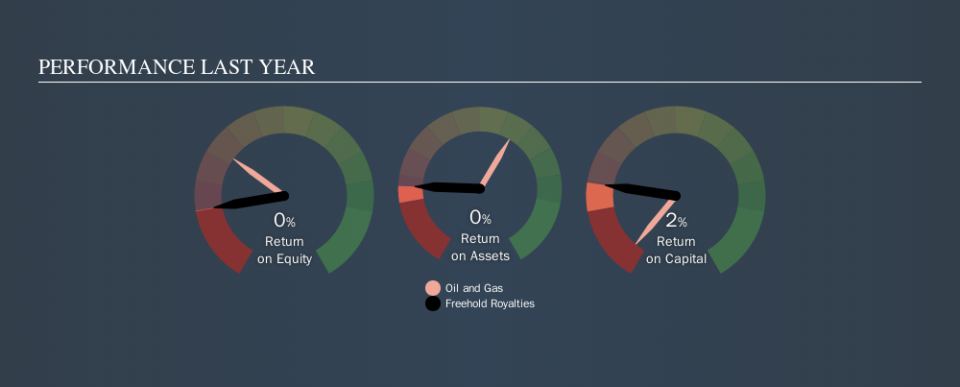Why Freehold Royalties Ltd.’s (TSE:FRU) Return On Capital Employed Might Be A Concern

Today we'll evaluate Freehold Royalties Ltd. (TSE:FRU) to determine whether it could have potential as an investment idea. To be precise, we'll consider its Return On Capital Employed (ROCE), as that will inform our view of the quality of the business.
First of all, we'll work out how to calculate ROCE. Next, we'll compare it to others in its industry. Last but not least, we'll look at what impact its current liabilities have on its ROCE.
What is Return On Capital Employed (ROCE)?
ROCE measures the 'return' (pre-tax profit) a company generates from capital employed in its business. In general, businesses with a higher ROCE are usually better quality. Ultimately, it is a useful but imperfect metric. Renowned investment researcher Michael Mauboussin has suggested that a high ROCE can indicate that 'one dollar invested in the company generates value of more than one dollar'.
How Do You Calculate Return On Capital Employed?
Analysts use this formula to calculate return on capital employed:
Return on Capital Employed = Earnings Before Interest and Tax (EBIT) ÷ (Total Assets - Current Liabilities)
Or for Freehold Royalties:
0.022 = CA$19m ÷ (CA$869m - CA$12m) (Based on the trailing twelve months to June 2019.)
Therefore, Freehold Royalties has an ROCE of 2.2%.
See our latest analysis for Freehold Royalties
Does Freehold Royalties Have A Good ROCE?
ROCE can be useful when making comparisons, such as between similar companies. Using our data, Freehold Royalties's ROCE appears to be significantly below the 5.6% average in the Oil and Gas industry. This could be seen as a negative, as it suggests some competitors may be employing their capital more efficiently. Independently of how Freehold Royalties compares to its industry, its ROCE in absolute terms is low; especially compared to the ~1.9% available in government bonds. There are potentially more appealing investments elsewhere.
Freehold Royalties reported an ROCE of 2.2% -- better than 3 years ago, when the company didn't make a profit. That suggests the business has returned to profitability. The image below shows how Freehold Royalties's ROCE compares to its industry, and you can click it to see more detail on its past growth.
When considering ROCE, bear in mind that it reflects the past and does not necessarily predict the future. Companies in cyclical industries can be difficult to understand using ROCE, as returns typically look high during boom times, and low during busts. This is because ROCE only looks at one year, instead of considering returns across a whole cycle. Given the industry it operates in, Freehold Royalties could be considered cyclical. What happens in the future is pretty important for investors, so we have prepared a free report on analyst forecasts for Freehold Royalties.
How Freehold Royalties's Current Liabilities Impact Its ROCE
Liabilities, such as supplier bills and bank overdrafts, are referred to as current liabilities if they need to be paid within 12 months. The ROCE equation subtracts current liabilities from capital employed, so a company with a lot of current liabilities appears to have less capital employed, and a higher ROCE than otherwise. To counteract this, we check if a company has high current liabilities, relative to its total assets.
Freehold Royalties has total assets of CA$869m and current liabilities of CA$12m. Therefore its current liabilities are equivalent to approximately 1.3% of its total assets. Freehold Royalties has a low level of current liabilities, which have a negligible impact on its already low ROCE.
The Bottom Line On Freehold Royalties's ROCE
Still, investors could probably find more attractive prospects with better performance out there. But note: make sure you look for a great company, not just the first idea you come across. So take a peek at this free list of interesting companies with strong recent earnings growth (and a P/E ratio below 20).
If you are like me, then you will not want to miss this free list of growing companies that insiders are buying.
We aim to bring you long-term focused research analysis driven by fundamental data. Note that our analysis may not factor in the latest price-sensitive company announcements or qualitative material.
If you spot an error that warrants correction, please contact the editor at editorial-team@simplywallst.com. This article by Simply Wall St is general in nature. It does not constitute a recommendation to buy or sell any stock, and does not take account of your objectives, or your financial situation. Simply Wall St has no position in the stocks mentioned. Thank you for reading.

 Yahoo Finance
Yahoo Finance 
